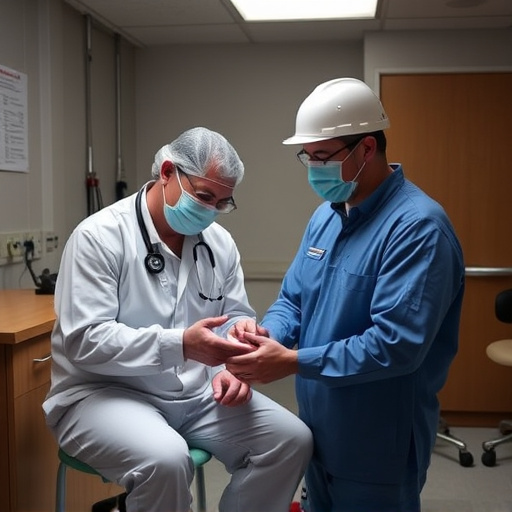Workers' Compensation is a vital safety net for employees injured on the job, offering financial support, healthcare access, and tailored services. To ensure effective workers compensation injury care, employees must promptly identify and document work-related injuries, keeping detailed records of medical treatments, communication with employers, and evidence collection. This process involves reporting the injury, seeking medical attention, maintaining comprehensive documentation, and adhering to insurance guidelines. Meticulous record-keeping strengthens claims, facilitates smooth processing, and promotes a culture of accountability among employers.
On-the-job injuries are a significant concern for any workplace, and proper treatment is essential for employee well-being and business continuity. This article explores the comprehensive process of managing work-related injuries, focusing on the role of workers’ compensation in providing critical care. We delve into identifying and documenting such injuries, navigating claims, understanding medical options, gathering evidence, and the profound impact of adequate documentation on successful claims resolution. By understanding these aspects, employers and employees can ensure effective treatment and support during challenging times.
- Understanding Workers' Compensation and Its Role in On-the-Job Injury Care
- Identifying and Documenting Work-Related Injuries
- Navigating the Claims Process: Steps to Ensure Proper Documentation
- Medical Treatment for On-the-Job Injuries: Rights and Options
- Building a Comprehensive Case: Gathering Evidence and Testimonies
- The Impact of Adequate Documentation on Injury Claims Resolution
Understanding Workers' Compensation and Its Role in On-the-Job Injury Care

Workers’ Compensation is a vital component of on-the-job injury care, designed to provide support and protection to employees who suffer workplace injuries or illnesses. This system offers a structured framework for managing and compensating for such incidents, ensuring that workers receive appropriate medical treatment and financial assistance during their recovery. When an employee sustains a work-related injury, they can file a claim with their employer or the relevant authority, initiating the process of obtaining necessary care.
The role of Workers’ Compensation extends beyond mere financial reimbursement. It also includes access to quality healthcare services, including medical assessments, treatments, and rehabilitation programs tailored to the specific needs of each injured worker. This comprehensive approach aims to facilitate a safe return to work or, if permanent disability is involved, ensures the employee receives fair compensation and support for their long-term well-being. Understanding Workers’ Compensation rights and procedures is crucial for employees, as it empowers them to navigate the system effectively and secure the care they need during challenging times.
Identifying and Documenting Work-Related Injuries

Identifying and documenting work-related injuries is a crucial step in ensuring adequate workers’ compensation injury care. When an employee sustains an injury on the job, it’s essential to recognize the incident promptly. This involves assessing the workplace environment, reviewing task performance, and understanding any pre-existing conditions that might contribute to or interact with the current injury. Proper documentation begins with a thorough report of the incident, including details like the date, time, location, and nature of the injury.
Accurate record-keeping is vital for facilitating efficient workers’ compensation claims. Employers should encourage employees to communicate any workplace hazards or concerns that might lead to injuries. This open dialogue helps in identifying patterns and implementing preventive measures. Detailed documentation includes medical records, witness statements, photographs, and equipment maintenance logs, all of which play a significant role in supporting the injured worker’s claim for compensation and ensuring they receive the necessary care.
Navigating the Claims Process: Steps to Ensure Proper Documentation

Navigating the claims process for a workers’ compensation injury is crucial, and proper documentation plays a vital role in ensuring a smooth and successful outcome. The first step is to report the injury promptly to your employer, as this initiates the legal claim. Following this, it’s essential to seek medical attention for appropriate diagnosis and treatment records, which serve as concrete evidence of the injury and its severity. These records should include details such as the date and nature of the incident, symptoms exhibited, and recommended care.
To ensure proper documentation, keep detailed records of all communications related to the injury. This includes conversations with your employer’s insurance representative, medical professionals, and any other relevant parties. Additionally, maintain a log of all provided documents, such as claim forms, diagnostic reports, and treatment plans. These steps will help streamline the claims process and support your case if any disputes arise regarding the injury or the care received.
Medical Treatment for On-the-Job Injuries: Rights and Options

When an employee sustains an injury on the job, they have a right to receive appropriate medical treatment for their condition. The first step is to report the injury to their employer or the designated person responsible for workers’ compensation claims. This triggers the process of obtaining necessary care, which can include emergency medical services, hospital visits, diagnostic testing, and specialist consultations. It’s crucial to keep detailed records of all treatments, diagnoses, and associated costs during this period.
Workers’ compensation insurance typically covers the cost of approved medical treatment for on-the-job injuries. This ensures employees receive the care they need without incurring significant out-of-pocket expenses. The insurance provider may authorize specific healthcare providers or facilities, and it’s important to adhere to their guidelines to ensure smooth claims processing. Employees have the right to seek a second opinion if needed and should document any issues or denials related to their workers’ compensation injury care.
Building a Comprehensive Case: Gathering Evidence and Testimonies

Building a comprehensive case for an on-the-job injury involves meticulous gathering of evidence and testimonies to support the claim. This process begins with documenting every detail of the incident, including the date, time, location, and sequence of events leading up to and during the injury. Any available witness statements should be collected, as these can provide crucial third-party corroboration. Additionally, medical records from the treatment for workers compensation injury care play a pivotal role in establishing the severity and causation of the harm.
Photographs of the work site, equipment, or other relevant items can serve as visual evidence to reinforce the narrative. It’s also important to maintain records of any communication with insurance providers, including correspondence, emails, and notes from adjusting officers. This comprehensive documentation forms a robust case that can significantly enhance the likelihood of a successful workers compensation injury claim.
The Impact of Adequate Documentation on Injury Claims Resolution

Adequate documentation plays a pivotal role in resolving on-the-job injuries smoothly and fairly. When an injury occurs, comprehensive records help facilitate the claims process by providing clear evidence of the incident, its immediate aftermath, and the extent of the worker’s injuries or disabilities. This includes detailed accounts from medical professionals, firsthand reports from witnesses, and official documentation from the employer regarding working conditions and training.
Such thorough documentation aids in expediting compensation claims for workers’ compensation injury care. It ensures that all parties involved—from insurance providers to legal representatives—have access to reliable information, reducing potential disputes and delays. Well-documented cases also empower employees to advocate for their rights, promoting a culture of accountability among employers.














